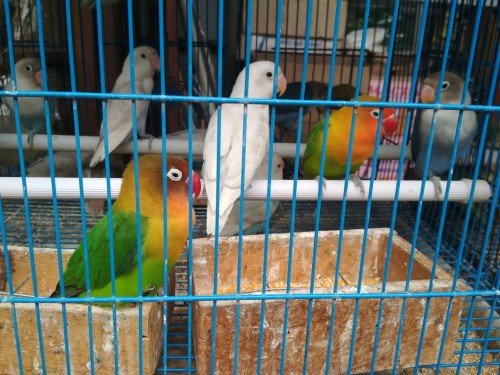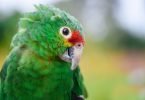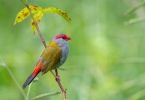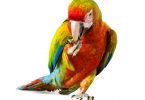Humans have always wanted to keep a ‘pet’ as a companion and the recipient of their affections. In return, humans are thought to receive ‘unconditional love’ (in most cases) and protection (in some cases). Having exotic birds of varied species and sizes as pets became the norm. However, with this newfound companionship comes various challenges, including knowing and dealing with the most common behaviors in pet birds.
Keeping exotic birds as pets, especially in the cities, came with a unique set of common behaviors in pet birds and related challenges. Whereas the other house pets could walk, run, climb, sit, etc., the birds needed to fly. Therefore these intelligent birds with their breath-taking, colorful plumage had to be caged to keep them from forsaking their loving new bird parents. However, many of these exotic birds become ill and die soon after being caged.
Challenges
A new dilemma arose due to the captive birds not being able to fly freely as they were naturally designed to do. Firstly, they were not getting sufficient exercise and stimulation. Secondly, humans were not sufficiently educated in bird farming to provide the birds with overall critical care. The cages were most often too small, resulting in cardiovascular and stress-related challenges in these pet birds.
During the 1980s, various governments restricted the import of Psittacine birds (a family of birds, also known as hookbills and include Macaws and Parakeets). The lack of stimulation from being taken out of their natural environment gave rise to health and psychological problems and some disturbing and unhealthy common behaviors in pet birds. The birds that survived in the cages started a new ‘captive bred‘ population of exotic birds. This abnormal situation caused the development of unique bird medical conditions.
Introduction of Wellness care for pet birds
Fortunately, with the advancement in modern avian medicine, the focus was eventually taken off infectious diseases and emergency interventions, to wellness care. These days, balanced nutrition, physical and psychological stimulation for healthy, holistic development plays a critical role in wellness programs for pet birds.
Through much research and new information, veterinarians are empowered to accurately diagnose and treat avian diseases and provide bird owners with critical education in caring for their pet birds holistically.
Species of birds that people keep as pets
People keep companion pet birds such as the smaller species like Budgies, small, medium, and the larger-sized parrots (Amazons, African Greys, Hawk-headed Parrots) Macaws, different species of Parakeets, Cockatoos, etc.
The best care for your pet birds starts with a suitable cage to accommodate the size of the bird so that there is sufficient space for movement and stimulation.
Minimum Cage Size and Bar Spacing Recommendations

Type of Bird | Size of Cage | Length X Width X Height (Inches) | Bar Spacing (Inches) |
Cockatiel, Parrotlet, Budgie, Lovebird | Small | 20 X 20 X 30 | 0.5 |
Poicephalus (All species of Parrots), | Medium | 36 X 24 X 48 | 0.75 |
African Grey Parrot, | Large | 40 X 30 X 60 | 0.751 |
Large Cockatoo, Macaw | Extra Large | 48 X 36 X 66 | 1.5 |
A wise selection of cage to prevent unhealthy common pet bird behaviors.
Pet bird owners are encouraged to invest in the largest cage size possible, taking cognizance of cost and space, of course! Think of a cage as a ‘sanctuary’ for your beloved pet. It should offer not only sufficient living space but also equally important protection and security (remember your pet cat!). Cages should be equipped with different-sized perches in a variety of textures, different bird toys, and the environment suited for foraging.
Lack of the necessary space and natural stimulation can present owners with unhealthy common pet bird behaviors that could be detrimental to the bird’s health and overall well-being.
Common behaviors in pet birds that require intervention
Pet birds, not much unlike kids and other pets, can sometimes become moody. They can change from being loving, playful feathered darlings to becoming demanding, distant, or sulking. Pet birds sometimes exhibit behaviors that can range from funny, to mildly disturbing, to absolutely irritating! Thank goodness that armed with research-based information, pet bird owners and veterinarians can help the birds overcome some unhealthy behaviors.
Some of the more common pet bird behaviors are the following:
Common behaviors in birds | Most common breed of pet bird displaying this behavior | Causes for this behavior | Symptoms | Veterinarian intervention and treatment |
Feather picking or plucking and skin mutilations | Mostly Cockatoos, love birds, Parrot family; Parrotlets, African Greys. | Medical or behavioral issues, stress, seeking attention from owners, loneliness –species normally live in large flocks inter-dependently in the wild - (Feather picking can progress into self-mutilation if left untreated). | Bald patches appear where feathers were plucked out, lots of feathers in the cage, an open wound may appear where feathers were plucked out and bird keeps on picking at wound/s. | a) A tube collar to stop further damage, |
Screaming and very loud noises | Most members of the Parrot family, African Greys, Macaws | Very intelligent birds that easily get bored, no provision for exercise (being let out of the cage to stretch their wings), not enough mental stimulation, stress, injury or illness, expression of happiness, calling to their ‘human’ flock! | Incessant screaming is a common behavior in pet birds especially when the bird is isolated. (parrots communicate and call within a large flock) | a) Lower noise levels of kids and other pets in the home, |
Incessant head bobbing | African Greys (shake their heads) | Most birds, specifically Macaws bob their heads up and down to regurgitate food to deposit in their mate’s mouth as a sign of their love and affection (also to bond with their owners). | Pet birds may bob their head up and down, it may pace to and fro in the cage, indicating that it wants to go 'somewhere’ or needing exercise. | a) Bobbing is normal behavior in most pet bird species as it is part of communication. |
Stress bars on the feathers | Mostly the Parrot family and Cockatiels but it does occur in other birds as well. | Poor nutrition and stress that was present while feather was being formed. Other possible causes: new location, new cage, losing a human or bird friend, anxiety. | Lines running horizontally across the feather and stunting further growth in that area, causing a deformity in the feather. | a) Avian experts advise teaching your pet bird something new using the clicker method. |
Nesting (and seemingly destructive behavior) | Parrot species and most other birds. | Nesting is induced by hormonal changes, mating season. Nest protects from predators. | Signs of nesting ‘syndrome’ are: Regurgitating frequently, crouching with wings drooped, aggression, frequenting darker corners, plucking own feathers and ripping material from perches and toys to build a nest. | a) Excellent nutrition, as nesting requires much energy, |
Molting | Parrots, Macaws, Cockatoos, and all other pet bird species. | Molting is a naturally occurring hormonal cycle among the most common bird behaviors. | Indications of molting are Loose feathers in the cage. (mostly coincides with hormonal changes and nesting behaviors. Moodiness, lack of interest in normal activities. | a) Molting requires more attention to good nutrition containing Calcium and Protein, |
Aggression | Parrots, African Greys; Cockatiels, Budgies - but this is a common pet bird behaviors triggered for various reasons. | Fear and trauma, unsocial behavior, disengaged from owners, jealousy of new pet, hormonal, and territorialism. | Hissing, biting, screaming, lunging and ruffling feathers threateningly are common behaviors in pet birds to communicate emotional distancing. | a) Handle your pet bird normally, no sudden jerking movements, |
Stress as a cause of common pet bird behaviors
The species of parrots being adopted as pet birds are highly intelligent, easily bored, and quickly stressed. When a parrot or any pet bird is stressed, it may start displaying unhealthy behaviors focused on its plumage or destroying items in the cage. In most cases, the bird will become ill and withdraw from its owner and refuse to eat.
Stress due to a lack of mental stimulation
Intelligent bird species like parrots, cockatiels, Macaws and African Greys need to have sufficient mental stimulation, especially if caged. Due to parrots having excellent memories, they may recall past traumatic incidences that caused severe stress. It could include loss or separation from a mate which can lead to the bird refusing all food. Sudden very loud sounds can cause the bird’s body to go into a state of severe stress resulting in physical illness.
Stress caused by physiological conditions
Due to pet birds being kept in cages, they are deprived of the natural flying activities they should be doing. Pet birds have to share an environment with humans, and artificial light and noise could deprive them of sleep. Besides, a deficiency in essential vitamins and minerals, metabolic, and disorders of the nervous system could contribute to elevated stress levels.
Once a bird is already suffering from stress, even naturally occurring biological processes become burdensome for the bird. Molting and other hormonal changes can cause severe anxiety and lead to undesirable and unhealthy common behaviors in pet birds, which requires intervention by an Avian Veterinarian. Most often, treatment would include a change in eating plan and medication to address the underlying causes of stress.
Stress caused by environmental factors
Parrots come from tropical climates where they are part of a large flock that is inter-dependent on one another for safety, food, and protection. Being isolated and put into a small cage can be a significant cause of stress and stress-related negative behaviors. Cages too small in size that restrict the bird’s movement, unsanitary conditions, bad lighting, unfavorable temperature, no consistency in the routine with human owners are causes of environmental stress in pet birds.
Social disengagement from the flock can lead to stress
As mentioned earlier, parrots form part of large flocks (sometimes a few hundred birds) in the wild. They are generally interdependent for safety, communication, food, and protection from predators.
For such a free, social, intelligent bird to spend time alone in a cage that may be too small is a major cause of stress and common disruptive behaviors in pet birds.
As a bird owner, you should enlist the help of the rest of the family to make it their ‘joyful duty’ to interact with your pet bird consistently. It will reduce the time that your pet bird spends in a solitary environment and reduce stress levels and trauma in your pet bird.
If your pet bird is satisfied, healthy, and happy, it will vocalize these emotions in the following manner.
- Whistling, talking and singing melodiously,
- Rather loud (or soft) chattering
- Purring, different to a cat’s purring, is much closer to a soft growling sound, most often a sign of contentment (or possibly expressing annoyance)!

Cleaning bird droppings
Cleaning droppings off the floor
Bird droppings are messy, can become rock hard and difficult to remove from your floor. Most importantly, it contains germs that can adversely affect humans. Similar transmissible diseases are common to geese, pigeons, house sparrows, and starlings. Histoplasmosis is a debilitating respiratory disease transmitted to humans through bird droppings, especially pigeons.
Method of effectively cleaning the surrounding environment:
- With a scraper, remove the hard, dried bird droppings off the floor,
- Sweep the area with a broom, using a dustpan to get rid of all the droppings.
- Make a 50/50 mixture of vinegar and water and put the mixture in a spray bottle.
- Spray the area encrusted with bird droppings and allow it to soak in for about 10-30 minutes.
- Use club soda to rinse off.
Cleaning your pet bird’s cage
- Hygiene is among the most critical aspects of caring for your pet bird. Neglecting this essential function can lead to distressing common pet bird behaviors. Line the bottom of the bird’s cage with either newspaper or disposable paper towel daily. Newsprint being free of lead is perfect to use for this purpose instead of the more expensive retail alternatives.
- You may have heard people scattering wood chips, shredded paper, shavings, corncob, and clay on the cage floor. It is potentially harmful to your pet bird in that it can cause respiratory ailments. These materials also do not allow you to monitor your pet bird’s droppings, which is essential to identify any health issues.
- Dust, fecal droppings, dust, feather dust, and food scraps constantly accumulate on the floor of your bird’s cage, impacting the whole cage. For this reason, a complete scrub-down of the whole cage with hot water and soap at least once a month is extremely important. Water containers and food dishes should be cleaned daily to maintain excellent hygiene to prevent parasites and diseases that normally cause unhealthy, harmful common behaviors in pet birds due to pain and stress of developing illnesses.
- Any porous material used inside your bird’s cage, such as bamboo, wicker, or wood, cannot be sterilized. It, therefore, has to be replaced at least every six months, up to a year.
Which disinfectant can be used to clean your pet bird’s cage?
The best method is to use hot water and soap for general cleaning and keeping the cage hygienically clean. Natural sunlight also serves as nature’s disinfectant. Hence cages can be ‘aired’ out and left to stand in the sun after being washed down.
Natural citrus-based household cleaning agents/disinfectants
There are also citrus-based cleaners/disinfectants that won’t adversely affect birds. These can be used for disinfecting and general washing of droppings from cage surfaces.
Chlorine bleach can also be diluted and used as a disinfectant as it’s reasonably safe. (to one-gallon water, add one cup of bleach). Chlorine bleach must only be used after all bird droppings have been washed off with soap and water, as direct contact with bird droppings may cause a toxic gas to form. It may be best to leave the cage in the sun for an hour or two after using bleach.
- Follow the directions on the labels of all products.
- Never mix different products as chemical reactions can be harmful to humans and birds.
Common Behaviors in Pet Birds due to Parasites
Parasites can be a significant cause of physical health issues in pet birds, which can affect people and other pets. As a bird owner, you should familiarize yourself with parasites that most commonly infect birds and recognize the symptoms caused by these pests. This knowledge is imperative to take prompt action at the sign of parasitic-induced illnesses in your pet bird.
The different types of parasites that infect birds
The most common types of parasites are listed here:
Parasite Name | Disease caused by a parasite | Birds commonly affected | Treatment and prevention |
Aspergillosis | Respiratory system | Parrots, Mallards, (also captive falcons and hawks) | Antibiotics (if diagnosed early). |
Giardia | The gastrointestinal system of the bird. Severe diarrhea, dehydration, loss of weight. Droppings resemble ‘popcorn’ Feather plucking and other common behaviors in pet birds may be observed due to itching. | Parrot family: Cockatoos, Macaws, Budgies, Cockatiels, and parrots. | Same as for Aspergillosis. Wash hands thoroughly with soap and hot water before and after handling your pet bird. |
Sarcocystis | One parasite causes muscular disease, the other attacks the bird’s neurological system and a third causes respiratory disease! | Parrot family; Macaws, Cockatoos, Cockatiels, Parrots, Budgies. | No cure for this parasitic infection as it shuts down all the bird’s organs. |
Scaly Face Mites | Scaly, white growths on the bird's beak, nostrils, mouth, and eyes. Another version of this parasite also cause growths on the bird’s legs. | Budgies and Canaries | Anti-parasitic medications administered via injection or orally as prescribed by an Avian veterinarian |
Preventing Parasitic Infection in Birds
As with all household pets, every precaution must be taken to prevent your pet bird from contracting parasitic illnesses. A balanced diet providing all nutritional requirements cannot be over-emphasized. A healthy immune system can naturally fight off most infections effectively.
Your bird’s living environment should be kept hygienically clean at all times, free of mold and fungi. Remember to wash your hands with soap and hot water for your bird’s and your protection.






